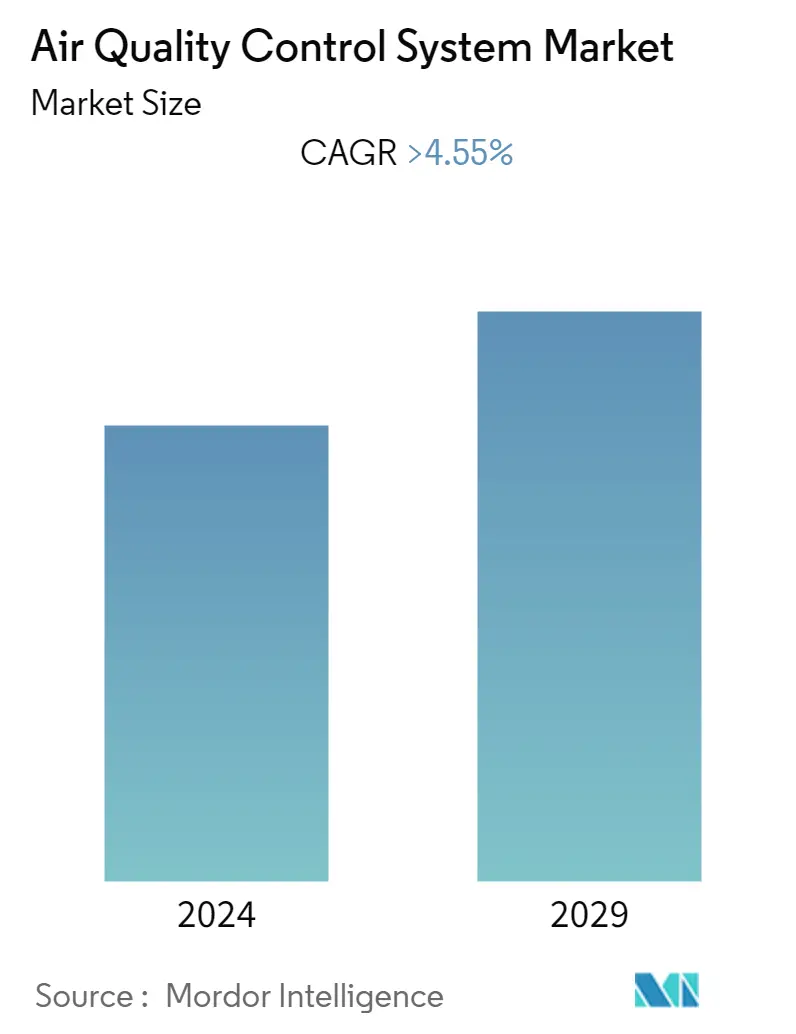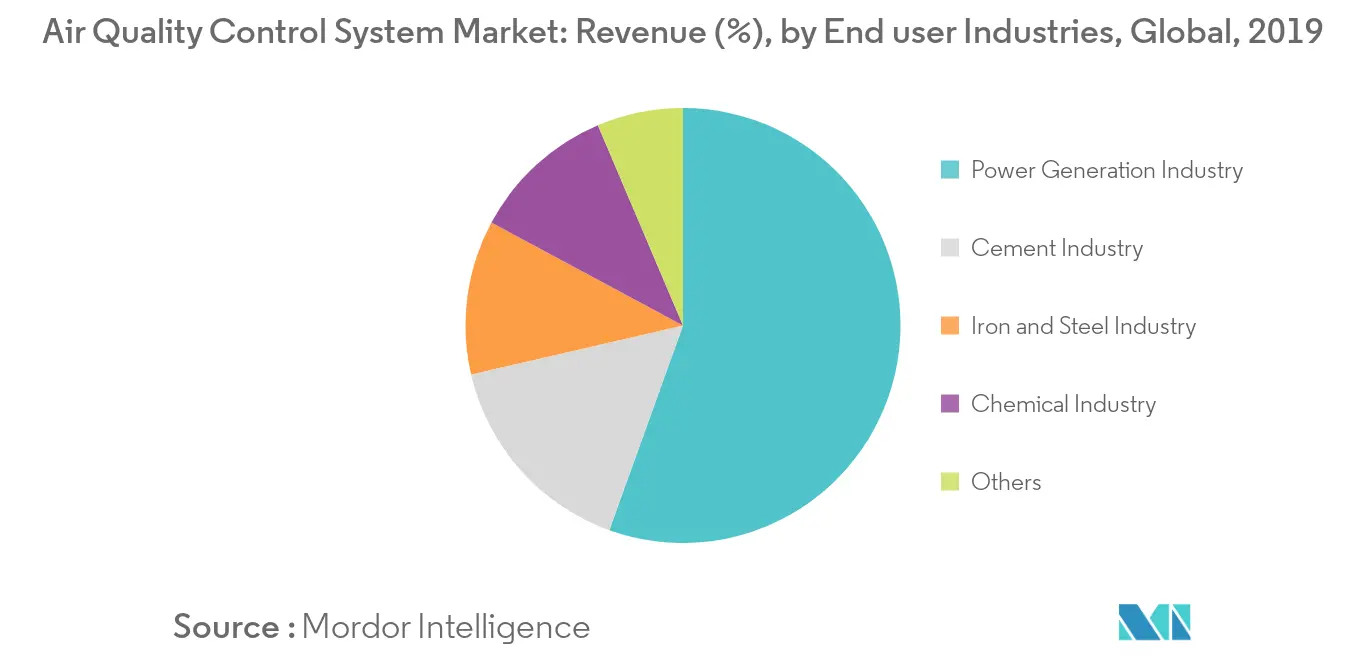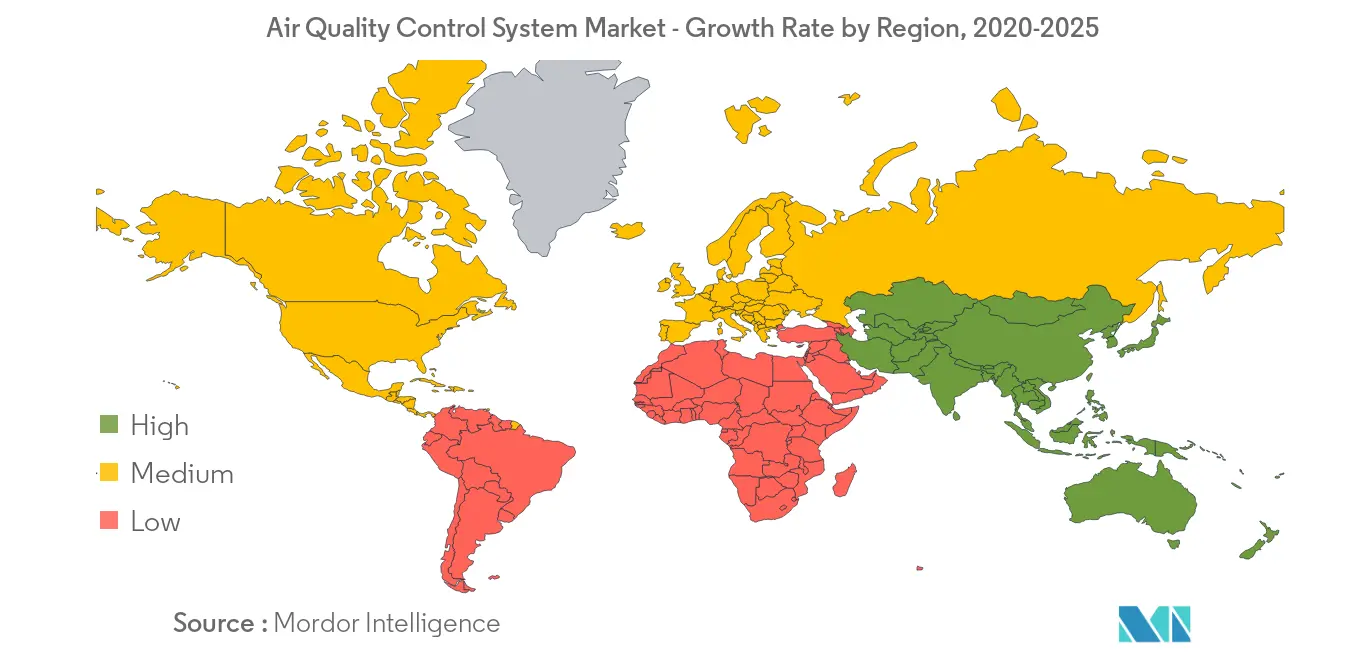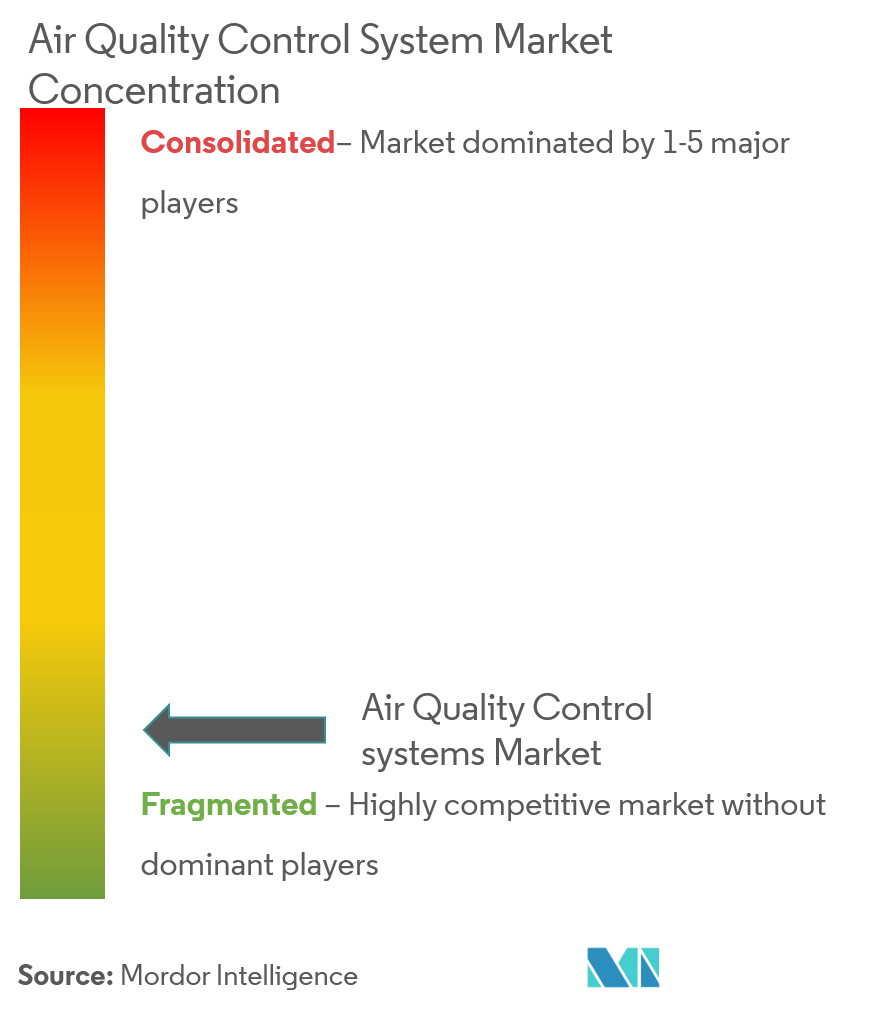Air Quality Control System Market Size

| Study Period | 2020 - 2029 |
| Base Year For Estimation | 2023 |
| CAGR | 4.55 % |
| Fastest Growing Market | Asia Pacific |
| Largest Market | Asia Pacific |
| Market Concentration | Low |
Major Players*Disclaimer: Major Players sorted in no particular order |
Air Quality Control System Market Analysis
The market for air quality control systems is expected to register a CAGR of approximately 4.55% during 2020- 2025. Major factors driving the market studied are the growing awareness among consumers, stringent air quality control regulations, growing end-user industries, and increasing awareness among common mass to mitigate health risks. However, the emergence of alternative and renewable sources of energy with reduced/zero emissions, and high capital required for the installation of air quality control system is expected to hinder the growth of the market studied.
- Power generation industry dominates the market and is expected to witness significant growth during the forecast period owing to the increasing pollution and growing industrialization.
- Retrofitting of old industrial plants with air quality control system to meet stringent regulatory norms set up by government is likely to acts as an opportunity in the future,
- Asia-Pacific dominated the market across the globe with the largest market being India & China owing to growing industrialization and construction activity leading to the increasing demand of air quality control system.
Air Quality Control System Market Trends
This section covers the major market trends shaping the Air Quality Control System Market according to our research experts:
Increasing Demand from Power Generation Industry
- In power generation industry, power plants are the largest sources of emission of SO2, mercury, and acid gases. In the power sector, coal accounts for around 98% of SO2 emissions, 94% of mercury emissions, 86% of NOx emissions, and 83% of fine particulate emissions. About 42% of the world's power in 2018 was generated using coal. The production of the aforementioned harmful gases can be minimized using air quality control systems (AQCS), such as, electrostatic precipitators, scrubbers, flue gas desulfurizers, and mercury control systems.
- The growing concerns regarding environmental pollution and government actions to curb the same are driving the market. Stringent international and government regulations, such as, the Clean Air Act (CAA), and the Mercury and Air Toxics standard enforce the installation of systems that monitor and curb emissions to bring them to a safer level, in power generation companies using fossil fuels
- Europe, which has mandated companies to employ high-quality AQCS, has the most stringent air pollution control laws for the industrial sector and with similar stringent laws been enforced in various regions the market for AQCS is expected to grow strongly during the forecast period.
- With increasing restriction on the emission level in various industries by the government agencies, the market for air quality control system in the power generation sector is expected to increase during the forecast period.

Asia-Pacific Region to Dominate the Market
- The exponential growth in the industrial sector (which includes power generation, cement manufacturing, and chemicals and metal processing) has influenced the demand for air quality control systems. With countries like China & India already topping the list of most polluted countries, the governments has been forced to implement laws and regulation for the emission standard in these countries forcing the pathway for the implementation of AQCS in industries.
- The increasing rate of coal consumption, illegal mining operations, and less efficient industrial processes have led to the deterioration of air quality. In addition, the growing per-capita energy consumption and demand for the same are the major factors responsible for the high levels greenhouse gas emissions. To control rising emission the Central Pollution Control Board(CPCB) has implemented air pollution control norms and standards that mandates the installation of air quality control systems in all industries.
- China adopted tough emission standards for sulfur dioxide (SO2), nitrogen oxide (NOx), and particulate matter (PM), for the newly constructed, and existing power plants in 2012 and 2014, respectively. In addition, all newly constructed and existing power plants are subjected to mercury emission standards from 2015 onwards. These environmental regulations have further propelled the demand for air quality control systems in the country.
- With the major economies trying to shift toward the renewable for the energy generation most coal-fired power plant are expected to get decommissioned during the forecasted period, which might lead to the stagnant growth of the market.

Air Quality Control System Industry Overview
The global air quality control system market is fragmented and the share of small number of buyers in the air quality control system manufacturers' sales is high. Some of the major companies include Mitsubishi Hitachi Power Systems Ltd, Thermax Ltd, Amec Foster Wheeler, Babcock & Wilcox Enterprises, Inc, Ducon Technologies Inc, General Electric, Fujian Longking Co. Ltd, and Siemens AG.
Air Quality Control System Market Leaders
-
Mitsubishi Hitachi Power Systems Ltd
-
Thermax Ltd
-
Amec Foster Wheeler
-
Babcock & Wilcox Enterprises, Inc
-
Ducon Technologies Inc
*Disclaimer: Major Players sorted in no particular order

Air Quality Control System Market Report - Table of Contents
1. INTRODUCTION
- 1.1 Scope of the Study
- 1.2 Market Definition
- 1.3 Study Assumptions
2. RESEARCH METHODOLOGY
3. EXECUTIVE SUMMARY
4. MARKET OVERVIEW
- 4.1 Introduction
- 4.2 Market Size and Demand Forecast in USD billion, till 2025
- 4.3 Recent Trends and Developments
-
4.4 MARKET DYNAMICS
- 4.4.1 Drivers
- 4.4.2 Restraints
- 4.5 Supply-Chain Analysis
-
4.6 Porter's Five Forces Analysis
- 4.6.1 Bargaining Power of Suppliers
- 4.6.2 Bargaining Power of Consumers
- 4.6.3 Threat of New Entrants
- 4.6.4 Threat of Substitute Products and Services
- 4.6.5 Intensity of Competitive Rivalry
5. MARKET SEGMENTATION
-
5.1 Application
- 5.1.1 Power Generation
- 5.1.2 Cement Industry
- 5.1.3 Iron & Steel Industry
- 5.1.4 Chemical Industry
- 5.1.5 Others
-
5.2 Type
- 5.2.1 Electrostatic Precipitators (ESP)
- 5.2.2 Flue Gas Desulfurization (FGD)
- 5.2.3 Scrubbers
- 5.2.4 Selective Catalytic Reduction (SCR)
- 5.2.5 Fabric Filters
-
5.3 Geography
- 5.3.1 North America
- 5.3.1.1 United States
- 5.3.1.2 Canada
- 5.3.1.3 Rest of North America
- 5.3.2 Asia-Pacific
- 5.3.2.1 India
- 5.3.2.2 China
- 5.3.2.3 Japan
- 5.3.2.4 Australia
- 5.3.2.5 Rest of Asia-Pacific
- 5.3.3 Europe
- 5.3.3.1 Germany
- 5.3.3.2 France
- 5.3.3.3 United Kingdom
- 5.3.3.4 Italy
- 5.3.3.5 Rest of Europe
- 5.3.4 South America
- 5.3.4.1 Brazil
- 5.3.4.2 Argentina
- 5.3.4.3 Chile
- 5.3.4.4 Rest of South America
- 5.3.5 Middle-East and Africa
- 5.3.5.1 Saudi Arabia
- 5.3.5.2 South Africa
- 5.3.5.3 Algeria
- 5.3.5.4 Rest of Middle-East and Africa
6. COMPETITIVE LANDSCAPE
- 6.1 Mergers & Acquisitions, Joint Ventures, Collaborations, and Agreements
- 6.2 Strategies Adopted by Leading Players
-
6.3 Company Profiles
- 6.3.1 Mitsubishi Hitachi Power Systems Ltd
- 6.3.2 Thermax Ltd
- 6.3.3 Amec Foster Wheeler
- 6.3.4 Babcock & Wilcox Enterprises, Inc
- 6.3.5 Ducon Technologies Inc
- 6.3.6 General Electric
- 6.3.7 Fujian Longking Co. Ltd
- 6.3.8 Siemens AG
- 6.3.9 Gea Bischoff
- 6.3.10 Hamon Corporation
- 6.3.11 Esco International
- 6.3.12 Horiba Ltd
- 6.3.13 Calgon Carbon Corporation
- 6.3.14 Pure Air Solutions
- 6.3.15 Tri-mer
- 6.3.16 Andritz Ag
- *List Not Exhaustive
7. MARKET OPPORTUNITIES AND FUTURE TRENDS
** Subject To AvailablityAir Quality Control System Industry Segmentation
The air quality control system market report include:
| Application | Power Generation | |
| Cement Industry | ||
| Iron & Steel Industry | ||
| Chemical Industry | ||
| Others | ||
| Type | Electrostatic Precipitators (ESP) | |
| Flue Gas Desulfurization (FGD) | ||
| Scrubbers | ||
| Selective Catalytic Reduction (SCR) | ||
| Fabric Filters | ||
| Geography | North America | United States |
| Canada | ||
| Rest of North America | ||
| Geography | Asia-Pacific | India |
| China | ||
| Japan | ||
| Australia | ||
| Rest of Asia-Pacific | ||
| Geography | Europe | Germany |
| France | ||
| United Kingdom | ||
| Italy | ||
| Rest of Europe | ||
| Geography | South America | Brazil |
| Argentina | ||
| Chile | ||
| Rest of South America | ||
| Geography | Middle-East and Africa | Saudi Arabia |
| South Africa | ||
| Algeria | ||
| Rest of Middle-East and Africa |
Air Quality Control System Market Research FAQs
What is the current Air Quality Control System Market size?
The Air Quality Control System Market is projected to register a CAGR of greater than 4.55% during the forecast period (2024-2029)
Who are the key players in Air Quality Control System Market?
Mitsubishi Hitachi Power Systems Ltd, Thermax Ltd, Amec Foster Wheeler, Babcock & Wilcox Enterprises, Inc and Ducon Technologies Inc are the major companies operating in the Air Quality Control System Market.
Which is the fastest growing region in Air Quality Control System Market?
Asia Pacific is estimated to grow at the highest CAGR over the forecast period (2024-2029).
Which region has the biggest share in Air Quality Control System Market?
In 2024, the Asia Pacific accounts for the largest market share in Air Quality Control System Market.
What years does this Air Quality Control System Market cover?
The report covers the Air Quality Control System Market historical market size for years: 2020, 2021, 2022 and 2023. The report also forecasts the Air Quality Control System Market size for years: 2024, 2025, 2026, 2027, 2028 and 2029.
Air Quality Control Systems Industry Report
Statistics for the 2024 Air Quality Control Systems market share, size and revenue growth rate, created by Mordor Intelligence™ Industry Reports. Air Quality Control Systems analysis includes a market forecast outlook to 2029 and historical overview. Get a sample of this industry analysis as a free report PDF download.



